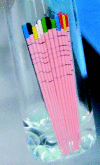Examination of gutta-percha cones for microbial contamination during chemical use
- PMID: 19466260
- PMCID: PMC4399541
- DOI: 10.1590/s1678-77572009000300022
Examination of gutta-percha cones for microbial contamination during chemical use
Abstract
Objective: The aim of this study was to evaluate the degree of microbial contamination in packaged gutta-percha cones before and during use in clinical conditions.
Material and methods: Sealed packages of #15-40 gutta-percha cones were opened under aseptic laboratory conditions. Two gutta-percha cones from each size were randomly drawn and added to tubes containing glass beads and 750 microL of saline. The tubes were vortexed, serially diluted and samples of 250 microL were cultured on agar plates. The plates were incubated at 37 degrees C for 3 days and colonies were counted. The initially sampled packages were distributed to 12 final year dental students. The packages were collected at the end of the first and the third clinical practice days and sampled as described above.
Results: Baseline microbial counts did not exceed 3 CFU. At the end of the first and the third day, additional contamination was found in five and three of the packages, respectively. The ratio of contaminated packages at the first day and the third day was not significantly different (z-test; p > 0.05). The numbers of microorganisms cultured at the first day (8 +/- 9.9 CFU) and the third day (4.5 +/- 8.3 CFU) were not significantly different (Wilcoxon signed-rank test; p > 0.05). No significant correlation was found between the number of filled root canals and cultured microorganisms at either the first day (Spearman's rho; r = 0.481, p = 0.113) or the third day (r = -0.034, p = 0.917).
Conclusions: Gutta-percha cones taken directly from manufacturer's sealed package harbored microorganisms. Clinical use of the packages has been found to be associated with additional contamination of the gutta-percha cones. The counts of cultured microorganisms did not correlate well with the number of filled root canals.
Figures
References
-
- Attin T, Zirkel C, Pelz K. Antibacterial properties of electron beam-sterilized gutta-percha cones. J Endod. 2001;27:172–174. - PubMed
-
- Beer R, Baumann MA, Kim S. Color atlas of dental medicine: Endodontology. In: Rateitschak KH, Wolf HF, editors. Instruments and materials. New York: Thieme; 2000. pp. 59–76.
-
- Doolittle TP, Rubel RL, Fried I. The effectiveness of common office disinfection procedures for gutta-percha and silver points. N Y State Dent J. 1975;41:409–414. - PubMed
-
- Gomes BP, Vianna ME, Matsumoto CU, Rossi Vde P, Zaia AA, Ferraz CC, et al. Disinfection of gutta-percha cones with chlorhexidine and sodium hypochlorite. Oral Surg Oral Med Oral Pathol Oral Radiol Endod. 2005;100:512–517. - PubMed
-
- Kayaoglu G, Erten H, Alaçam T, Ørstavik D. Short-term antibacterial activity of root canal sealers towards Enterococcus faecalis. Int Endod J. 2005;38:483–488. - PubMed
MeSH terms
Substances
LinkOut - more resources
Full Text Sources


